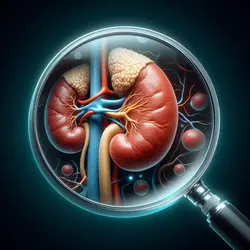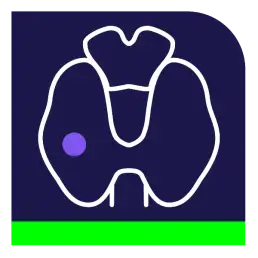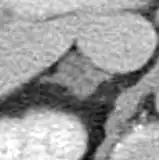Adrenal MRI Calculator for Chemical Shift
Reference:
Related Calculators:

More about the Chemical Shift Adrenal MRI Calculator
The chemical shift adrenal MRI calculator is an essential diagnostic tool designed to assist in the non-invasive evaluation of adrenal lesions. By leveraging the physics of fat and water resonance differences, this technique can identify the presence of intracellular lipid within adrenal nodules—an indicator strongly associated with benign adrenal adenomas. Integrating this calculator into your diagnostic workflow can streamline analysis and enhance confidence in distinguishing benign from malignant adrenal masses, particularly in incidentally detected adrenal findings.
Understanding Chemical Shift MRI
Chemical shift MRI operates on the principle that fat and water protons precess at slightly different frequencies within a magnetic field. By capturing images both when these signals are in-phase and out-of-phase, radiologists can detect subtle variations in signal intensity caused by the presence of microscopic fat—often found in lipid-rich adrenal adenomas. This method is particularly useful in characterizing adrenal nodules that are indeterminate on conventional imaging such as CT.
- Imaging Protocol:
- Both in-phase (IP) and out-of-phase (OOP) images are acquired, with the shortest possible echo times to reduce T2* decay effects.
- High-quality, high-resolution imaging sequences are necessary for accurate ROI placement and reliable intensity measurement.
- Reference Standard:
- The spleen is commonly used as a reference structure because it contains neither fat nor iron, allowing for a reliable comparison of signal intensity changes.
Key Indices Used in the Adrenal Chemical Shift Calculator
Two major quantitative indices are utilized to interpret chemical shift MRI findings:
- Signal Intensity Index (SII): This calculates the percentage of signal loss between in-phase and out-of-phase images. An SII greater than 16.5% typically indicates a lipid-rich adenoma.
- Adrenal-to-Spleen Ratio (ASR): This compares the signal intensity of the adrenal lesion to that of the spleen. A ratio of less than 0.71 is suggestive of a lipid-rich adenoma.
Why Use a Chemical Shift MRI Calculator?
Manual calculations of SII and ASR are prone to variability due to ROI placement and image noise. Our adrenal MRI calculator simplifies the process by guiding the user through signal measurement and performing automatic computation. This improves efficiency and minimizes potential errors during interpretation.
Technical Considerations for Optimal Use
- Scanner Specifications: Echo timing differs based on MRI field strength:
- 1.5T scanners: OOP ~2.2 ms, IP ~4.4 ms
- 3T scanners: OOP ~1.1 ms, IP ~2.2 ms
- T2* Decay and Artifacts: Use the shortest TE to limit signal decay. Image artifacts or motion can distort ROI measurements, so patient positioning and breath-holding are critical.
- Lesion Type: Not all adrenal lesions contain fat. Metastases, pheochromocytomas, and carcinomas usually lack microscopic fat and show no signal loss between sequences.
When Not to Rely Solely on Chemical Shift
Lesions that measure >10 Hounsfield units (HU) on unenhanced CT may not demonstrate fat on chemical shift imaging, even if benign. In these cases, CT adrenal washout protocols or contrast-enhanced MRI may provide more diagnostic clarity. This underscores the value of multimodality assessment when dealing with adrenal masses.
Clinical Significance of Chemical Shift MRI
Identifying benign adrenal adenomas through chemical shift imaging can spare patients from invasive biopsy or surgical intervention. It plays an important role in the workup of incidental adrenal lesions, particularly in oncologic patients or individuals undergoing abdominal imaging for unrelated reasons. The calculator aids radiologists in providing clear, quantitative data to referring clinicians, strengthening multidisciplinary decision-making.
Role in Adrenal Mass Evaluation Workflow
Chemical shift MRI is often part of a broader adrenal evaluation strategy, which may include unenhanced CT, contrast-enhanced washout studies (see our adrenal washout CT calculator), functional imaging with PET/CT, and lab evaluation of hormonal function. Together, these tools form a comprehensive approach to adrenal lesion characterization.
Conclusion
The adrenal chemical shift MRI calculator is a powerful adjunct to diagnostic radiology, especially when integrated thoughtfully into a broader diagnostic framework. By enabling rapid, reproducible assessment of signal changes, this calculator enhances diagnostic confidence and supports safe, evidence-based patient care in the evaluation of adrenal incidentalomas.
Frequently Asked Questions (FAQ)
- What is the purpose of chemical shift MRI in adrenal imaging?
It helps distinguish benign adrenal adenomas from malignant lesions by detecting microscopic fat within the nodule, which is common in adenomas but rare in metastases or carcinomas. - How does chemical shift MRI detect fat?
It compares signal intensity between in-phase and out-of-phase images. Adenomas with intracellular lipid show a signal drop on out-of-phase images, while non-adenomas do not. - What do the SII and ASR values mean?
A Signal Intensity Index (SII) greater than about 16.5% or an Adrenal-to-Spleen Ratio (ASR) below 0.71 generally indicates a lipid-rich adenoma. These thresholds help quantify signal loss objectively. - Can I rely only on chemical shift imaging to diagnose an adenoma?
No. Although it’s highly specific for lipid-rich adenomas, some benign lesions lack fat and won’t show signal loss. CT washout or hormonal evaluation may still be needed. - Does field strength (1.5T vs 3T) affect results?
Yes. Echo times for in-phase and out-of-phase imaging differ between 1.5T and 3T scanners, so correct protocol timing is important to ensure accurate detection of fat-related signal loss. - Why is the spleen used as a reference in the calculator?
The spleen has stable signal intensity and contains no fat or iron, making it a reliable comparison tissue when calculating ASR. - Can metastases or pheochromocytomas mimic adenomas on chemical shift?
Typically no. These lesions lack microscopic fat and maintain similar signal intensity between in-phase and out-of-phase images. - When should other imaging methods be used?
If the lesion is dense on CT (>10 HU) or shows no signal loss despite benign appearance, CT washout or contrast-enhanced MRI can provide further clarification. - Is chemical shift MRI useful for patients with known cancer?
Yes. It helps differentiate benign adenomas from metastatic deposits, which is especially important when adrenal lesions are incidentally found during cancer staging. - Does this calculator replace radiologist interpretation?
No. It supports accurate quantification but should always be used in conjunction with imaging review and clinical judgment.




